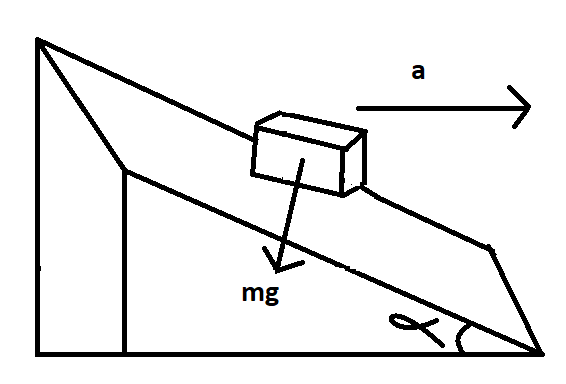
A block is kept on a frictionless inclined surface with an angle of inclination $\alpha $. The incline is given an acceleration ‘a’ to keep the block stationary, then ‘a’ is equal to.


Answer
588k+ views
Hint: The components of all the forces should be resolved by drawing a free body diagram. For the block moving with an acceleration ‘a’ a pseudo acceleration of equal magnitude acts on the inclined surface in the opposite direction.
Step by step answer:
The question involves the use of a free body placed on an inclined plane. The action and reaction forces acting on a body are always equal and in the opposite direction to each other. Here we will first draw a simplified Free body Diagram for the block kept on a frictionless inclined surface.

The angle of inclination is $\alpha $ and the mass of the block is given m. The force acting on the block vertically downward would be $mg$. On resolving the components of $mg$, we get $mg\sin \alpha $and $mg\cos \alpha $.
The inclination has an acceleration ‘a’ so there will be a pseudo force exerted by the block on the inclined surface acting in the opposite direction which is $ma$ . On resolving the components of $ma$ we get $ma\cos \alpha $and $ma\sin \alpha $.
We will equate the resolved components of forces $ma$and $mg$ acting on the block,
$R=mg\cos \theta $
$ma\cos \alpha =mg\sin \alpha $
$a=\dfrac{g\sin \alpha }{\cos \alpha }$
$a=g\tan \alpha $
Therefore, for the block to remain stationary the acceleration of the incline should be
$a=g\tan \alpha $
The correct answer is $a=g\tan \alpha $
Additional information:
For a body of mass m kept on an inclined plane at angle $\theta $ , normal reaction is given by $R=mg\cos \theta $
Note: While drawing the free body diagrams students should be careful with drawing the correct direction since it is an inclined plane. The weight $mg$ is straight downwards and the reaction force would be upwards perpendicular to the incline.
Step by step answer:
The question involves the use of a free body placed on an inclined plane. The action and reaction forces acting on a body are always equal and in the opposite direction to each other. Here we will first draw a simplified Free body Diagram for the block kept on a frictionless inclined surface.

The angle of inclination is $\alpha $ and the mass of the block is given m. The force acting on the block vertically downward would be $mg$. On resolving the components of $mg$, we get $mg\sin \alpha $and $mg\cos \alpha $.
The inclination has an acceleration ‘a’ so there will be a pseudo force exerted by the block on the inclined surface acting in the opposite direction which is $ma$ . On resolving the components of $ma$ we get $ma\cos \alpha $and $ma\sin \alpha $.
We will equate the resolved components of forces $ma$and $mg$ acting on the block,
$R=mg\cos \theta $
$ma\cos \alpha =mg\sin \alpha $
$a=\dfrac{g\sin \alpha }{\cos \alpha }$
$a=g\tan \alpha $
Therefore, for the block to remain stationary the acceleration of the incline should be
$a=g\tan \alpha $
The correct answer is $a=g\tan \alpha $
Additional information:
For a body of mass m kept on an inclined plane at angle $\theta $ , normal reaction is given by $R=mg\cos \theta $
Note: While drawing the free body diagrams students should be careful with drawing the correct direction since it is an inclined plane. The weight $mg$ is straight downwards and the reaction force would be upwards perpendicular to the incline.
Recently Updated Pages
Why are manures considered better than fertilizers class 11 biology CBSE

Find the coordinates of the midpoint of the line segment class 11 maths CBSE

Distinguish between static friction limiting friction class 11 physics CBSE

The Chairman of the constituent Assembly was A Jawaharlal class 11 social science CBSE

The first National Commission on Labour NCL submitted class 11 social science CBSE

Number of all subshell of n + l 7 is A 4 B 5 C 6 D class 11 chemistry CBSE

Trending doubts
What is meant by exothermic and endothermic reactions class 11 chemistry CBSE

1 Quintal is equal to a 110 kg b 10 kg c 100kg d 1000 class 11 physics CBSE

Difference Between Prokaryotic Cells and Eukaryotic Cells

What are Quantum numbers Explain the quantum number class 11 chemistry CBSE

What is periodicity class 11 chemistry CBSE

Explain zero factorial class 11 maths CBSE




